#tarotthothqabalahelitarotstrickingly.com
Above all things, Know Thyself!

Thoth- Queen of Wands
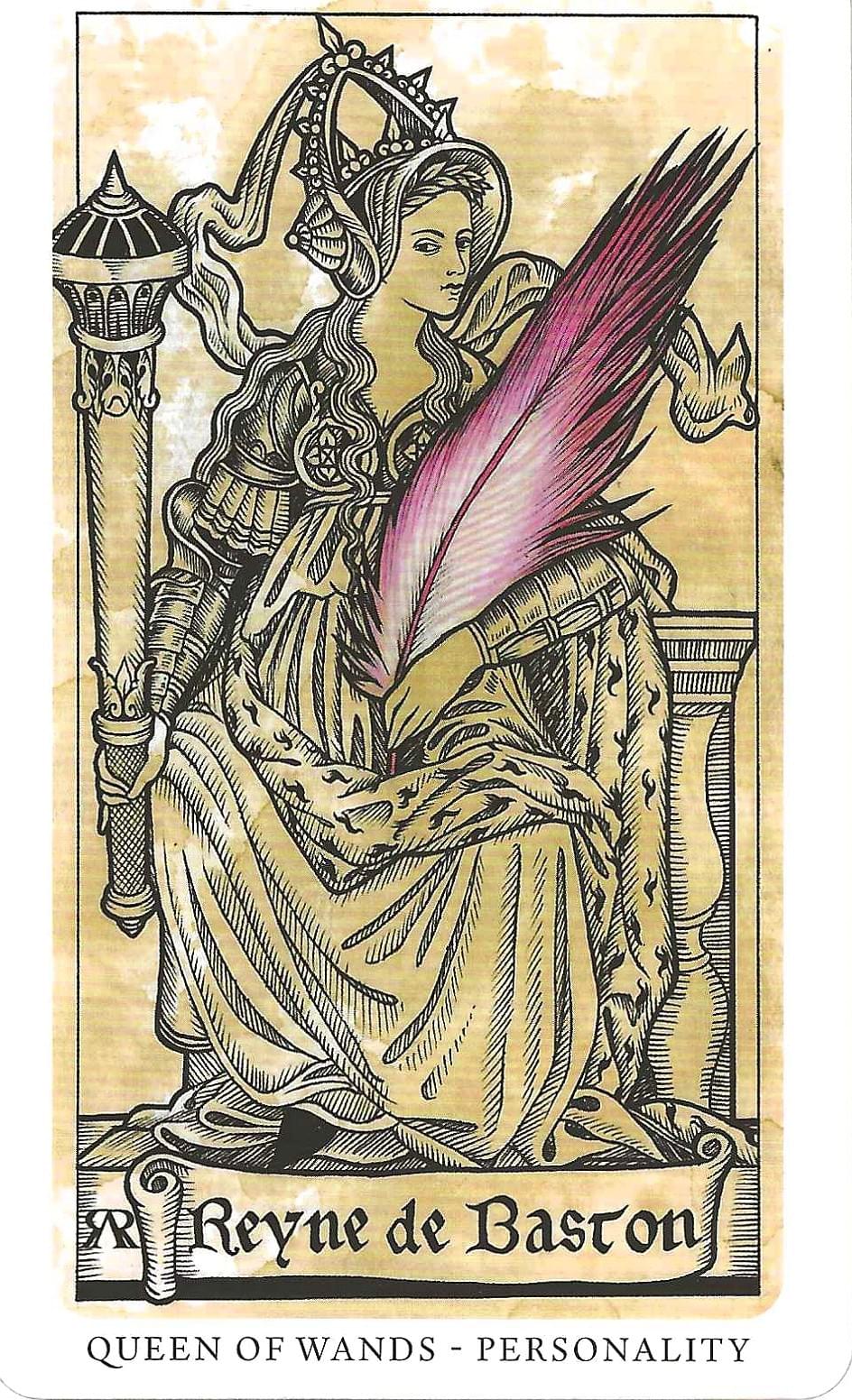
The Medieval Feathers Tarot- Queen of Wands

Medieval Dragon and Salamander
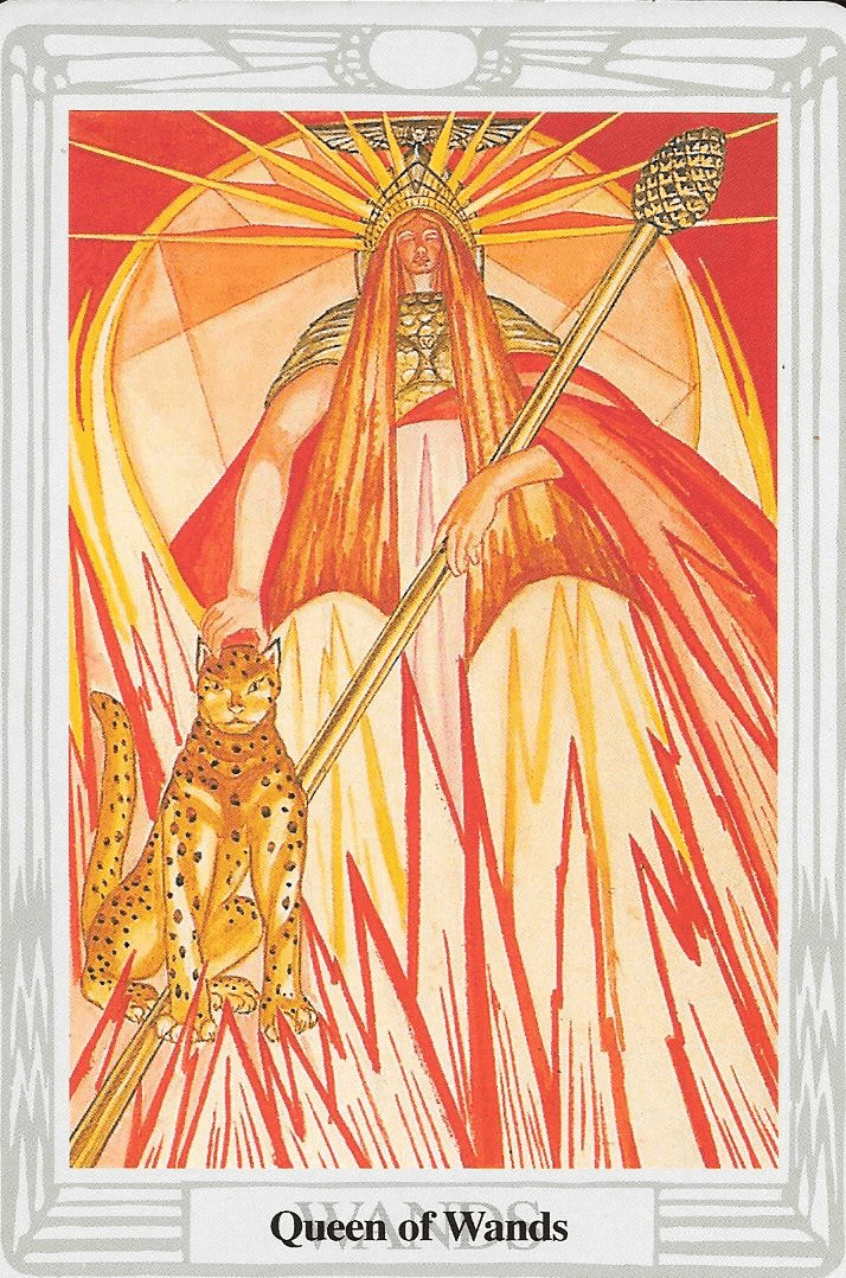
Thoth Tarot – Queen of Wands
Queen of the Thrones of Flame
Queen of the Salamanders
The Thoth Queen of Wands embodies the fiery essence of materialized force. She is not abstract potential, nor the intellectual schematizing of flame—she is the living throne of fire. The Salamanders (or Salamandines, as medieval alchemists called them) are her children and attendants. In the Middle Ages, these “fire elementals” were regarded as spirits that could live within flame itself. Today, in Hermetic Qabalah, they serve as symbolic metaphors for the undying, transmuting power of fire within the psyche.
Unlike the Princes and Knights, the Queens do not govern through angelic or cosmic intermediaries; rather, they are the palpable realization of power in form. For this reason, no angelic hosts surround her—only the living flame made conscious through the elemental beings of fire. In her, spirit has descended into embodiment.
Astrological Attributions
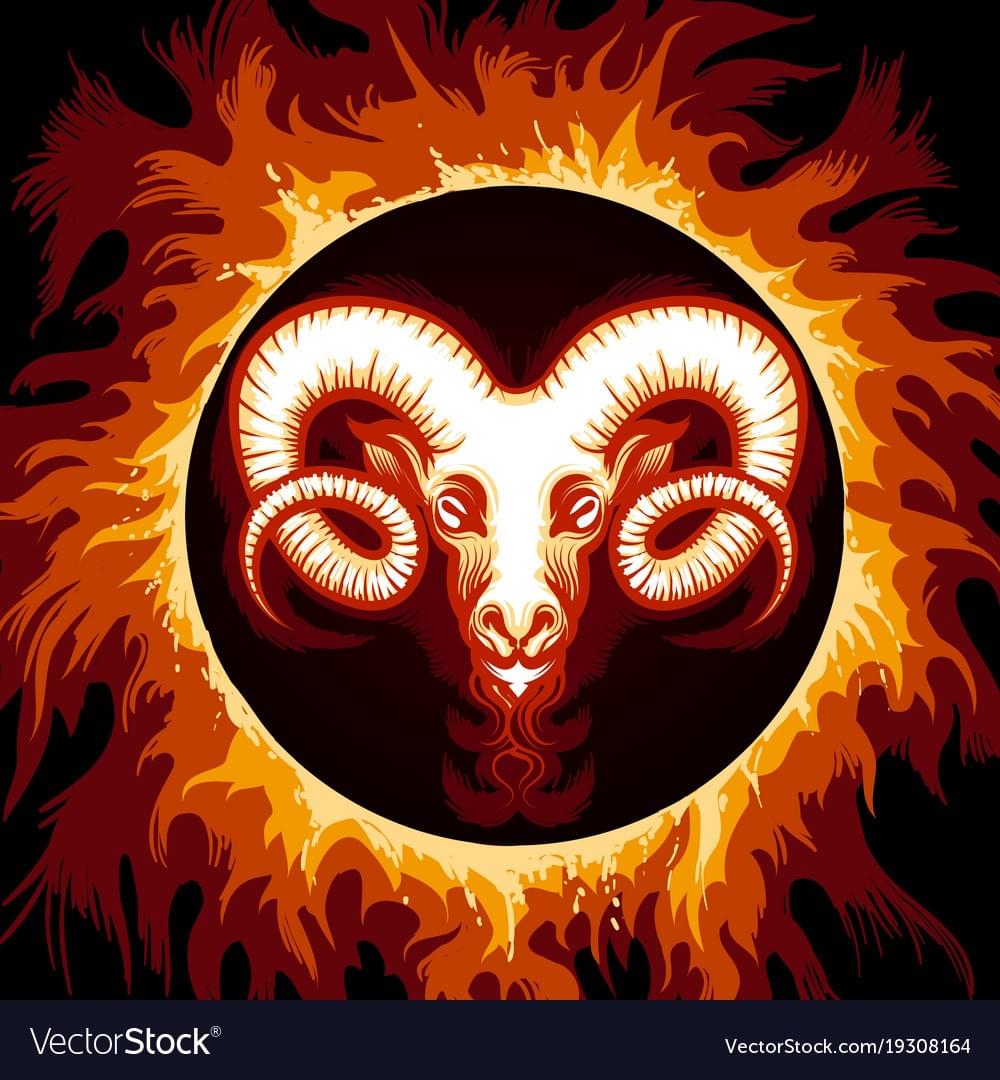
Her dominion is the last decan of Pisces and the first two decans of Aries. Thus, she straddles the Piscean dissolution of boundaries and the Aries ignition of will. She is both the last flame flickering in the twilight of the zodiac and the first spark of dawn. Her fire consumes the dross of the old cycle and sets ablaze the new.
This dual rulership makes her power intensely transformative. She burns away illusions of self-sacrifice (Pisces) and replaces them with a sovereign spark of direct action (Aries). One may feel her influence as the irresistible drive to ignite change, even if it destroys the familiar in order to create the new.
Hermetic Metaphor – Fire Within
To encounter the Queen of Wands is to awaken the Salamander within. Her elementals are not fanciful fairy-tale sprites but interior forces of transmutation. They leap up from the subconscious in flashes of passion, in sudden surges of courage, in fierce loyalty to one’s own truth.
The medieval mind externalized these powers as fiery spirits; the Hermetic initiate knows they are the immortal flames hidden in the soul. In practice, one may summon her not by calling to outer elementals but by kindling inner fire through meditation, devotion, and creative daring.
Divinatory Significance
Upright: Fiery self-possession, courage in adversity, the embodiment of sovereignty, mastery over one’s passions without extinguishing their vitality. A figure who commands not through law or word, but by the radiant fact of her presence.
Reversed: Fire turned destructive—jealousy, vindictiveness, uncontrolled passion. The Salamanders turn wild and consume the one who fails to govern them.

In medieval mystical and esoteric traditions, particularly those influenced by alchemical and Hermetic thought, salamanders were considered one of the four elemental spirits, each corresponding to one of the classical elements. Salamanders specifically represented fire.
Origins and symbolism:
The idea of salamanders as fiery elementals likely arose from the real-life salamander's behavior and habitat. Salamanders often emerged from logs or wood when exposed to heat or flames, as they dwell in damp environments. This phenomenon led to the mistaken belief that they were born of or lived in fire, giving them an association with the element.
Role in Esoteric Thought
In the Western Hermetic tradition, these creatures were classified among the elemental beings:
- Gnomes: Earth
- Undines: Water
- Sylphs: Air
- Salamanders: Fire
Salamanders symbolized the transformative, purifying, and consuming power of fire. They were seen as the fiery spirit within flames and were thought to embody the creative and destructive aspects of fire, reflecting its dual nature.

Paracelsus and the Salamanders
The concept of salamanders as fiery elementals was popularized by the 16th-century alchemist and mystic Paracelsus. In his work Liber de Nymphis, Sylphis, Pygmaeis et Salamandris et de caeteris spiritibus, Paracelsus elaborates on the elemental spirits, describing salamanders as the spirits of fire who inhabit flames and volcanic regions. He portrayed them as both literal and metaphorical representations of fiery energy and inspiration.
Symbolism in Mysticism and Magic
Salamanders are associated with:
- Passion and creativity: Fire represents energy, enthusiasm, and the spark of life.
- Transformation: Fire purifies and transforms substances in alchemy, symbolizing spiritual renewal and enlightenment.
- Destruction and renewal: They remind practitioners of the cyclical nature of destruction and creation.
In medieval and Renaissance art, salamanders were often depicted surrounded by flames, emphasizing their fireproof and fiery nature.
Modern Interpretations
In contemporary esoteric practices, salamanders are sometimes invoked or meditated upon to connect with the fiery aspects of the self, such as willpower, courage, and passion. They also serve as symbols for the fire element in ritual magic, particularly in traditions influenced by Hermetic Qabalah.
Their enduring presence in mystical lore highlights the rich tapestry of symbolic associations humanity has woven around the natural world.
Eliphas Lévi, the influential 19th-century French occultist, did express caution about working with elemental spirits, including salamanders, in his writings. Lévi's warnings are rooted in his broader perspective on the dangers of summoning or invoking entities without proper knowledge, preparation, and spiritual discipline.
Key Warnings in Lévi's Philosophy:
Respect for the Elementals: Lévi viewed elementals as powerful yet morally neutral beings that lacked the immortal soul of humans. He believed they were driven by their inherent nature—playful, mischievous, or destructive, depending on the element. Invoking salamanders (or any elemental) without understanding their fiery nature could lead to unintended consequences.
Mastery of Self: In Dogme et Rituel de la Haute Magie (Transcendental Magic: Its Doctrine and Ritual), Lévi emphasized the importance of the magician mastering their own passions, desires, and fears before attempting to work with external forces. Since salamanders are closely associated with fire, symbolizing passion and transformation, they could amplify internal imbalances if the practitioner was not spiritually prepared.
Risk of Obsession: Lévi warned that elementals could ensnare a practitioner who lacked clarity of purpose or strength of will. Salamanders, in particular, could ignite overwhelming emotions, uncontrolled ambition, or destructive tendencies if their fiery energy was not carefully channeled, very much like the improper invocation of the plasmic Kundalini forces in a human body.
Misdirection of Energy: Lévi noted that invoking elementals required precise alignment with the corresponding element. Any misstep could result in chaotic or harmful energies, especially with an element as volatile as fire.
Practical Interpretation of Lévi's Warnings
Lévi did not outright forbid the invocation of salamanders but advised:
- Caution and Respect: Approach salamanders with reverence and humility. They are not forces to be controlled but energies to be harmonized with.
- Preparation: Ensure you are grounded and spiritually balanced before working with elemental forces.
- Purposeful Invocation: Only invoke salamanders with a clear and constructive intention, such as seeking courage, purification, or transformation.
- Spiritual Evolution: Lévi believed that the goal of magic was the elevation of the soul. Invocations should always align with this higher purpose.
Why the Caution About Salamanders Specifically?
Among the elementals, salamanders represent the most volatile and transformative element—fire. Fire’s dual nature as a force of creation and destruction can easily overwhelm those unprepared to handle its intensity. Lévi likely highlighted these risks to ensure that practitioners approached such forces responsibly.
Summary
Eliphas Lévi did not outright forbid the invocation of salamanders but warned against the risks of doing so without the necessary preparation and spiritual discipline. His advice remains relevant to modern practitioners: invoking salamanders (or any elemental) requires respect, self-mastery, and a clear understanding of the energies involved.

Pele
Thoth Tarot – Queen of Wands
Water of Fire, Thrones of Flame
The Queen of Wands in the Thoth Tarot is one of the most potent expressions of primal force made conscious. Lady Frieda Harris painted her as a living volcano — broad at the base, narrowing toward the heights, crowned with fire, the human form itself becoming a mountain of flame. This volcanic imagery unites her with Pele, the Polynesian goddess of fire and volcanoes, whose wrath and passion both destroy and renew. Pele is a perfect archetype of the Queen of Wands personality: fiery, uncompromising, yet also deeply creative, bringing new land, new life, and new beginnings through the very violence of her eruptions.

At her crown hovers the winged solar disc, a Sumerian-Egyptian symbol of the Anunnaki and later Ra. In the Queen’s hands, it signals that her fire is not merely terrestrial but cosmic — the “flame from heaven” embodied on earth.
Water of Fire – Conscious Energy
The suit of Wands is Fire, but each court is a fusion of element within element. Thus, the Queen is Water of Fire. At first glance this seems absurd — how can water and fire coexist? But within the Hermetic system, Water is consciousness and Fire is Spirit / Will. The Queen of Wands is therefore the conscious awareness of primal will — energy that knows itself, ardor married to insight.
Both fire and water are hydrogen-oxygen mysteries: one explosive, one fluid, both essential to life. In the Queen, they join as Vital Force made aware of itself, passion tempered into sovereignty.
Symbols in the Card
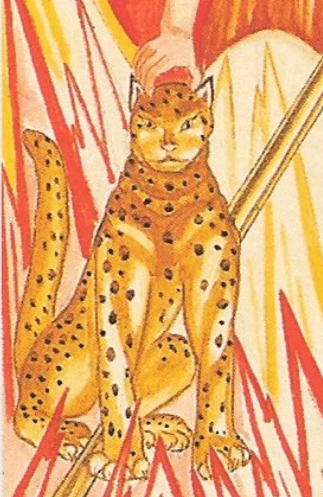
Throne of Flames: She sits in complete mastery of the very fire that would consume a lesser being. This throne does not support her; it is her natural domain.
The Leopard: The Queen rests her hand upon the leopard — an animal whose spotted skin suggests the interplay of light fire and dark fire, of shadow and radiance. Black panthers, leopards with hidden ghost-spots, show this mystery even more clearly: the subconscious fire burning beneath the conscious blaze. Her hand upon it signifies her conscious command over the primal instincts. She rules passion; passion does not rule her.
The Wand of Dionysus (Thyrsus): Topped with pinecone and crowned with flame, this wand represents ecstasy, intoxication, and the fertile madness of Dionysian fire. In her hand, the Wand is not reckless abandon but directed will — ecstasy harnessed into purpose.

Hermetic Paradox – Shadow and Light
The Queen of Wands holds dominion over both sides of the flame: the visible light and the hidden shadow. She teaches that shadow is not to be destroyed but mastered; instinct and desire are not to be denied but guided. Her rulership is the sovereignty of integration — the animal and divine, the subconscious and conscious, the dark fire and the light fire all fused under her will.
She is the mistress of passion without slavery, of power without disintegration. In her, the Salamanders — once feared medieval fire elementals — are revealed as inner forces, the spirits of our own volcanic depths.
Mythic Persona
One may invoke her in the guise of Pele, or in the Egyptian mode as the Solar-Winged Goddess, or even as the Dionysian Queen. Each of these masks speaks to the same essential fire: conscious will embodied in sovereign passion.

Dionysus and his Thyrsus.
The Thyrsus is a symbol of Dionysian rituals and is often depicted as a staff or wand topped with a pinecone, ivy leaves, and sometimes grapevines. Here's a brief overview:
Symbolism: The Thyrsus is a symbol of fertility, abundance, and the revelry associated with Dionysus. It represents the lush and wild aspects of nature.
Components:
- Pinecone: The pinecone atop the Thyrsus is believed to represent the evergreen nature of the pine tree, symbolizing immortality and the cycle of life / death and in Western Hermetic Mysteries is also compared to the cone shaped*** pineal gland.
- Ivy Leaves: Ivy is often intertwined with the Thyrsus, symbolizing the clinging, persistent nature of life. Ivy is also associated with Dionysus due to its connection with wine and wine culture.
- Grapevines: Grapes and vine leaves are also common additions to the Thyrsus, underscoring Dionysus's association with wine, celebration, and the grape harvest.
Use in Rituals: The Thyrsus played a significant role in Dionysian rituals. It was used by the followers of Dionysus, known as Bacchants or Maenads, during ecstatic celebrations and orgiastic rites. It was often used to strike the ground, causing water to flow, symbolizing the rejuvenation of the earth.
Spiritual Significance: In your practice of Western Hermetic Qabalah and High Magick, you might find the Thyrsus to be a symbol of the divine connection between the earthly and spiritual realms. It can be used as a tool for channeling energy and intention.
Modern Interpretations: In contemporary spirituality, the Thyrsus can be seen as a symbol of transformation, the union of opposites, and the power of ecstasy and altered states of consciousness.

The ***pineal gland, often referred to as the "third eye," is a small endocrine gland located deep within the brain, in the epithalamus, near the center of the brain. Despite its small size (typically around the size of a grain of rice), the pineal gland plays a crucial role in various physiological functions and has been associated with numerous mystical and spiritual beliefs throughout history.

In the study of Western Magick, the pineal gland is often attributed with several mystical and metaphysical characteristics. These attributions stem from various esoteric traditions, including Hermeticism, Theosophy, and certain strands of the Western Occult tradition. Here are some key characteristics and symbolic associations applied to the pineal gland in these contexts:
1. Third Eye and Inner Vision
- Third Eye Chakra: In esoteric traditions, the pineal gland is frequently associated with the "third eye," a mystical inner eye that is believed to provide perception beyond ordinary sight. This concept is analogous to the Ajna chakra in Hindu and Buddhist traditions, which is located in the forehead and is associated with intuition and spiritual insight.
- Inner Vision: The pineal gland is thought to be a gateway to higher consciousness, allowing individuals to access deeper levels of awareness and spiritual understanding.
2. Seat of the Soul
- Descartes' Theory: The 17th-century philosopher René Descartes famously referred to the pineal gland as the "seat of the soul," suggesting it was the principal seat of the rational soul and the place where thoughts are formed.
- Soul Connection: In Western Magick, this idea is extended to suggest that the pineal gland is a link between the physical body and the spiritual realms, facilitating communication with higher dimensions and spiritual entities.
3. Production of DMT
- Psychoactive Substance: Some modern esoteric thinkers propose that the pineal gland produces dimethyltryptamine (DMT), a powerful psychoactive substance. DMT is sometimes called the "spirit molecule" for its profound effect on human consciousness, often described as producing mystical or transcendent experiences.
4. Light Sensitivity and Circadian Rhythms
- Light Sensitivity: The pineal gland is sensitive to light and plays a crucial role in regulating sleep-wake cycles through the production of melatonin. Esoterically, this light sensitivity is often interpreted as a symbolic reflection of its ability to perceive spiritual light or enlightenment.
- Circadian Rhythms: The regulation of circadian rhythms is sometimes linked to the idea of aligning with natural and cosmic cycles, which is a common theme in many magical and spiritual practices.
5. Symbolic Representations
- Pine Cone Symbolism: The pineal gland's name is derived from its pine cone-like shape. Pine cones are often used as symbols of enlightenment, immortality, and spiritual awakening in various esoteric traditions.
- Serpent Imagery: In Kundalini yoga and other spiritual traditions, the activation of the pineal gland is sometimes represented by the image of a coiled serpent rising along the spine, symbolizing the awakening of spiritual energy.
6. Activation and Awakening Practices
- Meditation and Visualization: Practices such as meditation, visualization, and certain yogic exercises are believed to stimulate the pineal gland, enhancing spiritual awareness and psychic abilities.
- Diet and Detoxification: Some esoteric traditions suggest that dietary changes and detoxification can help decalcify and activate the pineal gland, making it more receptive to spiritual experiences.
These characteristics highlight the pineal gland's central role in bridging the physical and spiritual realms within Western Magick and other esoteric traditions. The gland is often seen as a key to unlocking higher states of consciousness and achieving spiritual enlightenment.

The Wand of Dionysus – Thyrsus and the Pineal Fire
In the Thoth Queen of Wands, the staff she holds is not a simple rod. Its pine-cone head unmistakably recalls the Thyrsus, the sacred wand of Bacchus/Dionysus carried by the Maenads in ecstatic rites. In Greek tradition the Thyrsus was both a channel of intoxication and a weapon of liberation. With it, the Maenads struck down the rigid structures of society and self, dissolving boundaries through frenzy and divine possession.
This symbol links the Queen of Wands to the mysteries of Dionysus, which were always double-edged: wine and blood, ecstasy and terror, liberation and dismemberment. She embodies not the blind frenzy of the Maenads, but the sovereign mastery of that same current — the conscious intoxication of divine fire.
On a subtle level the pine-cone atop the wand suggests the pineal gland, the “seat of the soul” in Hermetic physiology, whose serpentine awakening by Kundalini leads to inner intoxication and the opening of clairvoyant and clairsentient faculties. In Dionysian myth, the Thyrsus “turns water into wine”; in Hermetic practice, the rising inner fire transforms ordinary consciousness into ecstatic gnosis.
Where the Maenads were seized by god, the Queen of Wands is possessed of herself. She does not merely drink the wine of Bacchus; she becomes the vintner, the priestess of the inner vineyard whose vintage is solar fire distilled into consciousness.
A Hermetic Reading of the Symbol
Pine-Cone / Pineal: Seed of immortality; the latent gland of inner sight and synthesis.
Thyrsus / Wand: Will wielding ecstasy; directing the current rather than being overwhelmed by it.
Water into Wine: Transformation of the raw psychic flow into spiritual intoxication, energetic gnosis.
Maenads: Archetype of ungoverned energy; the Queen represents the same power sublimated into sovereignty.
“Those who wish to go deeper into the pineal-Kundalini mysteries of the Thyrsus may study the Dionysian Mysteries, the Hermetic pineal doctrines, and the alchemical marriage of Water and Fire. The Queen of Wands is their living emblem.”

Maenad and Thyrsus also used to fend off Satyrs.
The Thyrsus as Wand and Weapon
The Thyrsus of Dionysus, depicted in the Queen of Wands, was more than a symbol of intoxication. In myth, the Maenads — wild priestesses of Bacchus/Dionysus — used the pine-coned wand as a weapon. With it they drove off satyrs and intruders, channeling divine frenzy not merely for ecstasy, but for defense and empowerment.
This dual nature of the Thyrsus reveals much about the Queen of Wands:
She holds a staff that both awakens inner intoxication (ecstasy, clairvoyance, solar kundalini rising) and serves as an instrument of authority and protection.
Like the Maenads, she wields passion as a force that can repel violation or imbalance.
Where satyrs represent uncontrolled lust, appetite, or lower instinct, the Queen of Wands raises her wand and directs that fire. She channels frenzy into sovereignty, desire into creative will.
Esoteric Paradox
In Hermetic symbolism, the Maenads’ defensive use of the Thyrsus against satyrs mirrors the inner work: the conscious self (the Queen) must guard its sovereignty against invasive instinct (the satyr). Yet the weapon is not iron or steel — it is a living wand crowned with a pine-cone, a staff of fertility, ecstasy, and awakening. The defense of sovereignty is thus accomplished not by repression, but by sublimation. The fire is not denied — it is mastered.
That way, your Queen of Wands becomes not just “Pele-volcanic” or “Dionysian intoxication,” but also the priestess who fends off intrusion, who channels her own frenzy rather than being overrun by it.

The Qabalistic Binah, the 3rd Sephiroth on the Tree of Life, is called the Sanctifying Intelligence known as Understanding. The Queens are another aspect of this Sanctifying Intelligence. Shown seated and enthroned, the Queens represent the forces of Heh (meaning window or sight) the willful force of the Divine Feminine of each suit. By bringing forth a material and/or Maternal Force of each suit, the Queens develop and realize the Will-to-Force of the King. This is a steady, unshaken, and enduring-Creatrix Force that is not as rapid in motion, as are the princes and/or Sons.

In the Thoth Tarot Deck, the Queen cards represent a mature and nurturing aspect of their respective suits. Each Queen embodies the characteristics of her suit in a fully developed, feminine form. These cards reflect qualities such as creativity, intuition, receptivity, and emotional depth. Here is an overview of each Queen card in the Thoth Tarot Deck and what they represent:
Queen of Wands
- Element: Fire
- Astrological Association: Aries, Leo, Sagittarius
- Characteristics: The Queen of Wands embodies the fiery, dynamic energy of the Wands suit. She is confident, charismatic, and full of life. This Queen represents someone who is passionate, independent, and capable of inspiring others. She is a natural leader and has a strong presence.
- Symbolism: The imagery often shows a powerful, radiant woman holding a wand, sometimes accompanied by a lion or a cat, symbolizing strength, courage, and independence.
Queen of Cups
- Element: Water
- Astrological Association: Cancer, Scorpio, Pisces
- Characteristics: The Queen of Cups represents the emotional and intuitive aspects of the Cups suit. She is compassionate, empathetic, and deeply in touch with her inner feelings and those of others. This Queen symbolizes nurturing, healing, and psychic abilities.
- Symbolism: The imagery typically depicts a serene woman with a cup or chalice, often surrounded by water or aquatic elements, highlighting her connection to emotions and intuition.
Queen of Swords
- Element: Air
- Astrological Association: Gemini, Libra, Aquarius
- Characteristics: The Queen of Swords embodies the intellectual and analytical qualities of the Swords suit. She is perceptive, honest, and wise, with a sharp mind and a keen ability to discern truth. This Queen represents clarity, objectivity, and effective communication.
- Symbolism: The imagery usually features a regal woman with a sword, often positioned in a way that suggests justice and discernment. Clouds or birds might be present, symbolizing the element of air and intellectual clarity.
Queen of Disks (Pentacles)
- Element: Earth
- Astrological Association: Taurus, Virgo, Capricorn
- Characteristics: The Queen of Disks (also known as Pentacles) represents the nurturing and practical aspects of the Disks suit. She is grounded, resourceful, and deeply connected to the material world. This Queen symbolizes abundance, fertility, and the ability to provide for oneself and others.
- Symbolism: The imagery often shows a nurturing woman with a pentacle or disk, surrounded by lush, fertile landscapes. This highlights her connection to nature, prosperity, and physical well-being.
General Symbolism of Queens in the Thoth Tarot
- Mother Archetype: Each Queen represents the mature, motherly archetype of her suit, embodying the nurturing and caring aspects in their respective domains.
- Feminine Energy: They all reflect the receptive, intuitive, and creative qualities associated with feminine energy.
- Maturity and Mastery: The Queens indicate a level of mastery and maturity in their suits, suggesting someone who has fully developed the qualities and attributes of their element.
In summary, the Queen cards in the Thoth Tarot Deck symbolize the mature, nurturing, and fully developed aspects of their respective suits. They represent the integration of the elemental energies in a balanced and harmonious way, highlighting qualities such as compassion, intuition, intelligence, and practicality.
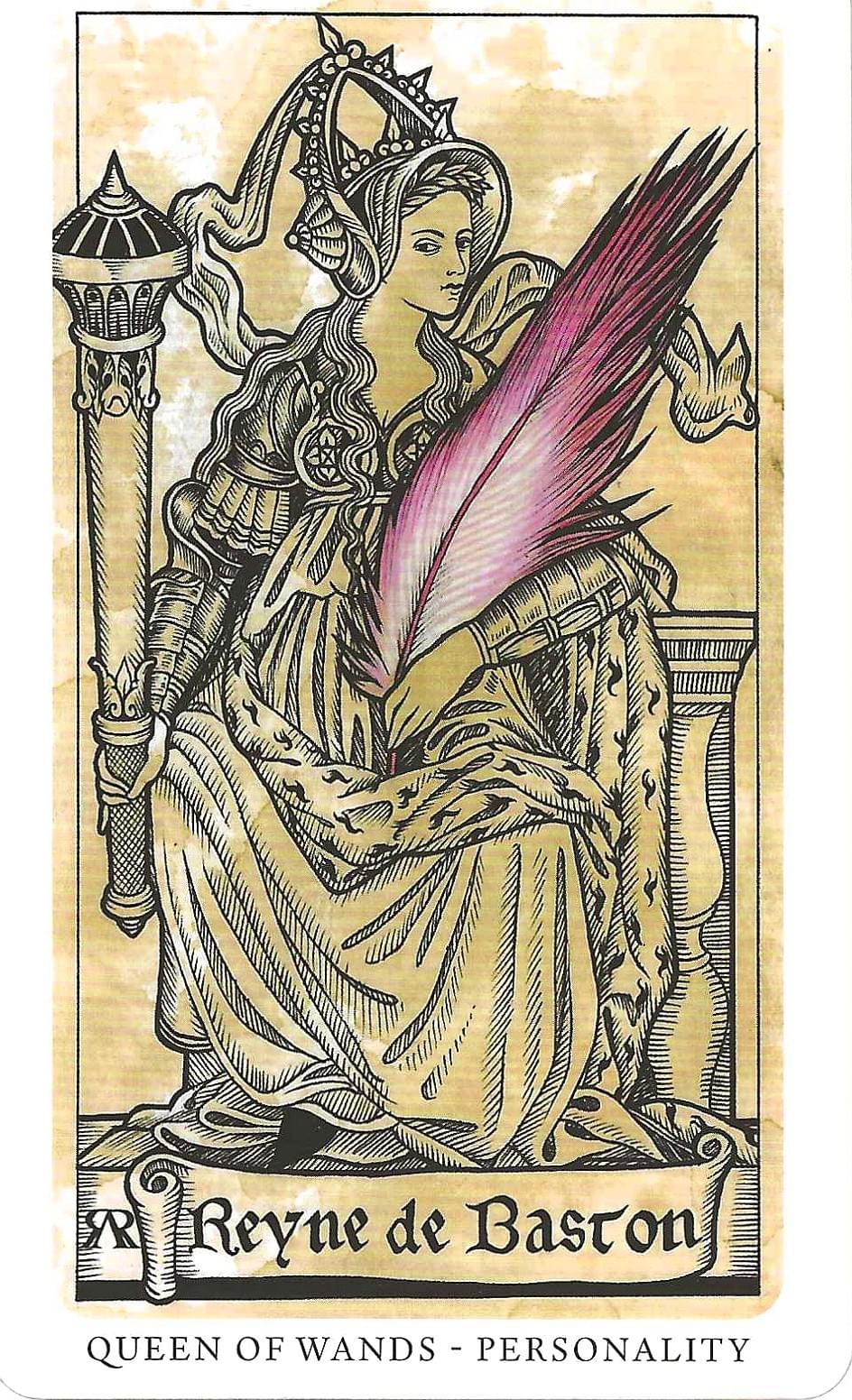
Medieval Feathers Tarot – Queen of Wands
In the Medieval Feathers Tarot, the Queen of Wands appears as a regal but offended monarch, seated amid courtiers whose laughter and loose tongues offend her sense of dignity. Here the lesson is subtler but equally powerful: do not let others drag your worth into the mud. Her staff is her reminder of self-knowledge and self-possession.
The roseate spoonbill’s feather and her composed attire mark her as an example of authenticity and refinement in the face of crassness.
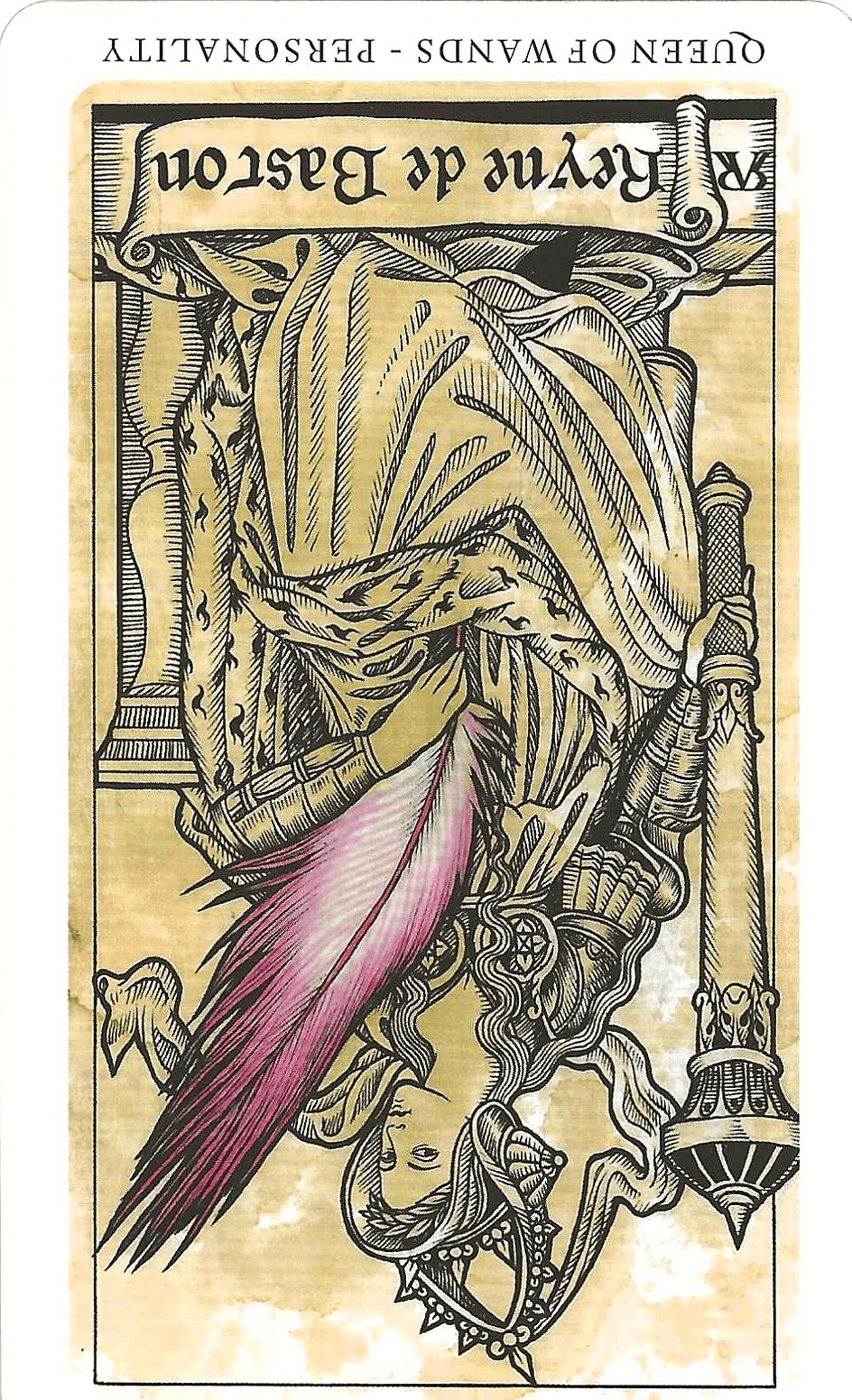
Reversed, the card warns of the opposite: falling into falsity, adopting poor examples, using intimidation instead of sincerity — a dangerous game that erodes true authority.
Keywords: Integrity, authenticity, self-representation, resisting peer pressure, being true to yourself.
Thoth Tarot – Queen of Wands
The Thoth Queen of Wands is volcanic power personified: Pele, the fiery sovereign, enthroned upon flames with leopard at her side and Thyrsus in her hand. She embodies Water of Fire — conscious awareness of primal will. Her card is about sovereignty through integration of shadow and light, passion directed by consciousness, and the fierce radiance of self-mastery. Her lessons are volcanic: to tame and direct the inner Salamanders (fiery instincts), lest they consume the bearer.
Keywords: Sovereignty of fire, volcanic personality, self-mastery, passion under conscious direction, integration of shadow and light.
Hermetic Contrast
Thoth Queen: volcanic sovereignty, the power of Pele and Dionysus, primal passion under conscious control.
Medieval Feathers Queen: social sovereignty, the strength of composure, setting an example amidst chaos.
Both Together: The Queen of Wands teaches that sovereignty is both inner and outer. Internally, she commands fire and shadow; externally, she sets the tone of dignity and authenticity. In both aspects, her power lies in knowing herself and ruling through that self-knowledge.

The Tarot Personality Birth-Wheel

Joan Crawford · Born-March 23rd, 1904
Archetypal Persona of the Queen of Wands
The Queen of Wands is not a girlish flame; she is mature fire, sovereign fire, volcanic fire with a human face. In personality terms, she often manifests as a powerful, sexually magnetic woman who channels passion into command and creativity. Think of Joan Crawford — a strong presence, uncompromising, elegant yet fierce, who embodied the commanding magnetism of the Queen of Wands archetype.
This card signals someone whose sexual energy is inseparable from their creative potential. Great sexual vitality equals great creative power, but such force must be focused. If diffused or left unchecked, it can ignite conflict and chaos — “all Hell breaks loose,” as you put it. The Queen’s lesson is mastery: to pour fire into art, vocation, leadership, or creation, so that the blaze becomes illumination rather than destruction.

Hel in Helheim.
Hel – The Dark Throne of Fire
The figure on the Queen’s throne is sometimes compared to the Norse goddess Hel, ruler of the underworld. This adds a crucial layer: her fire is not only passion and creativity, but also descent into shadow. Hel governs the realm where the dead are cleansed of memory and identity before rebirth. So too the Queen of Wands sits enthroned in flame, sovereign of the underworld of deep, dark emotions.
She is not afraid of the abyss; she rules it. The volcanic Queen, the Dionysian Maenad, and Hel are all masks of the same sovereignty: the power to confront shadow, transform it, and turn it into the fuel for new life.
Esoteric Implications
Creative Fire: Passion transformed into art, vocation, or spiritual vocation.
Sexual Fire: Sexual magnetism as a form of radiance and sovereignty.
Underworld Fire: Emotional catharsis, descent into shadow, ritual cleansing and rebirth.
Personality Archetype: A commanding woman, alluring yet dangerous, whose will allows no opposition
The Swedish actress Ursula Andress was also such a strong personality.

Ursula Andress · Born
Mar 19, 1936
Character of the Queen of Wands
Crowley describes her as possessing “adaptability, persistent energy, and calm authority which she knows how to use to enhance her attractiveness. She is kind, generous, but impatient with opposition. She has an immense capacity for friendship and for love, but always on her own initiative” (Book of Thoth, p. 152).
This passage highlights the paradox of the Queen of Wands: she is not passively receptive like a stereotypical “water-queen,” but actively sovereign. She gives generously, loves deeply, and inspires loyalty — yet only on her own terms. Friendship, love, or passion arise by her initiative, never by compulsion. Her energy is radiant, but her sovereignty is absolute.
When combined with the card’s volcanic and Dionysian imagery, these traits reveal her as a figure of intoxicating magnetism — a woman whose calm confidence heightens her allure. She attracts not by submission but by commanding presence. Her adaptability makes her fiery power versatile; her persistence ensures she is never extinguished; her calm authority means her flame burns steady, not erratic.
Yet, true to her volcanic nature, she does not tolerate opposition. Her impatience with resistance reflects her archetypal role as Pele, Hel, and the Dionysian Queen: she is the sovereign flame, and one either accepts her radiance or is consumed by it.

Albert Einstein-March 14, 1879
The Queen of Wands personality can also be that of a male, for example, especially if the man is more intuitive than rational, as she is Intuition, Imagination, Empathy, etc. Albert Einstein was such a man.

Wyatt Earp-March 18, 1848
Therefore, one can see that the Queen like personality of "one who must be obeyed" (From H. Rider Haggard's science fiction story of She), does not pertain to a gender of the individual, but rather a birthdate that forms the core personality. Wyatt Earp is an example of this Queen of Wands personality's non-gender. I Am also sure that if anyone called gun toting Marshal-Wyatt Earp a "Queen" to his face, they expired in a rapid 45 caliber-manner. Therefore, there is a violent downside to this wonderful personality, for this one can take offense easily, and in a selfish sort of way, loves "their" people but is often so self-absorbed that when the opportunity for personal love presents itself, they may become cruel, tyrannical, and savage. Resulting in the person's unhappiness and eventual destruction.

Crowley described this Fiery personality in his Book of Thoth, on Page 153, as one who "when she misses her bite, she breaks her jaw!" But this is the shadow side of such a one. This Queen can be everything the world needs in a strong woman and/or man.

The Queen of Wands – The Flaming Crown of Understanding
The Queen of Wands, robed in fire and crowned with dancing dragon-flames, represents the ultimate feminine authority of the Tarot courts. She is the embodiment of the Creatrix-Understanding — the maternal principle of Binah, the 3rd Sephirah on the Tree of Life. “Understanding” (Binah) is not passive knowledge, but the power to shape, enclose, and transform raw force into form. Through her, the Divine She reveals Herself across all suits of Tarot, manifesting as the womb of sovereignty and the flame of confidence.
Her flames do not consume her; they are her vestment. She is both warmth and power — radiant, glowing, and alive with Water of Fire, the paradox of consciousness (Water) infused with Spirit (Fire). The dragon-flame crown emphasizes her solar authority, radiating not only beauty but also terrifying sovereignty.

The Mature Feminine Archetype
On the personal level, the Queen of Wands represents a mature, experienced, and practical woman who knows her place and power. She is:
Sexually attractive and self-possessed – her allure comes from confidence, not dependence.
Independent and strong-willed – she will not be subdued, for her fire is her own.
Energetic and outgoing – she radiates vitality, often inspiring others to rise with her.
Fair but impatient with opposition – she will not waste time with those who would diminish her or dilute her flame.
This is the archetype of the sovereign woman, magnetic in both creativity and authority.

The Leopard / Panther Mystery
What is absent in some renditions — though emphasized in the Thoth card — is the presence of the leopard or panther, animals sacred to the goddess. The leopard is a dual symbol: its dark spots suggest shadow fire amidst light fire, embodying the mysteries of the subconscious passions beneath conscious control. In myth, the panther is sensual, dangerous, and fiercely independent — a living emblem of feminine power that refuses to be tamed.
Thus, the feline at her side symbolizes both her sensual magnetism and the dangerous edge of her independence. To those who wish to subdue her, the Queen is perilous. To those who honor her sovereignty, she is radiant warmth and loyalty.
Qabalistic Implication
In the Tree of Life, the Queen of Wands reflects the principle of Binah (Understanding) in the fiery suit of Wands. She is the throne upon which fiery force takes form — maternal fire made conscious. This is the flame of self-confidence, the intelligence that shapes passion into creativity, and sexuality into sovereignty.
This final framing makes her not just “the fiery queen” but the manifest Creatrix, the Understanding that rules Fire, and the archetype of the radiant sovereign woman.
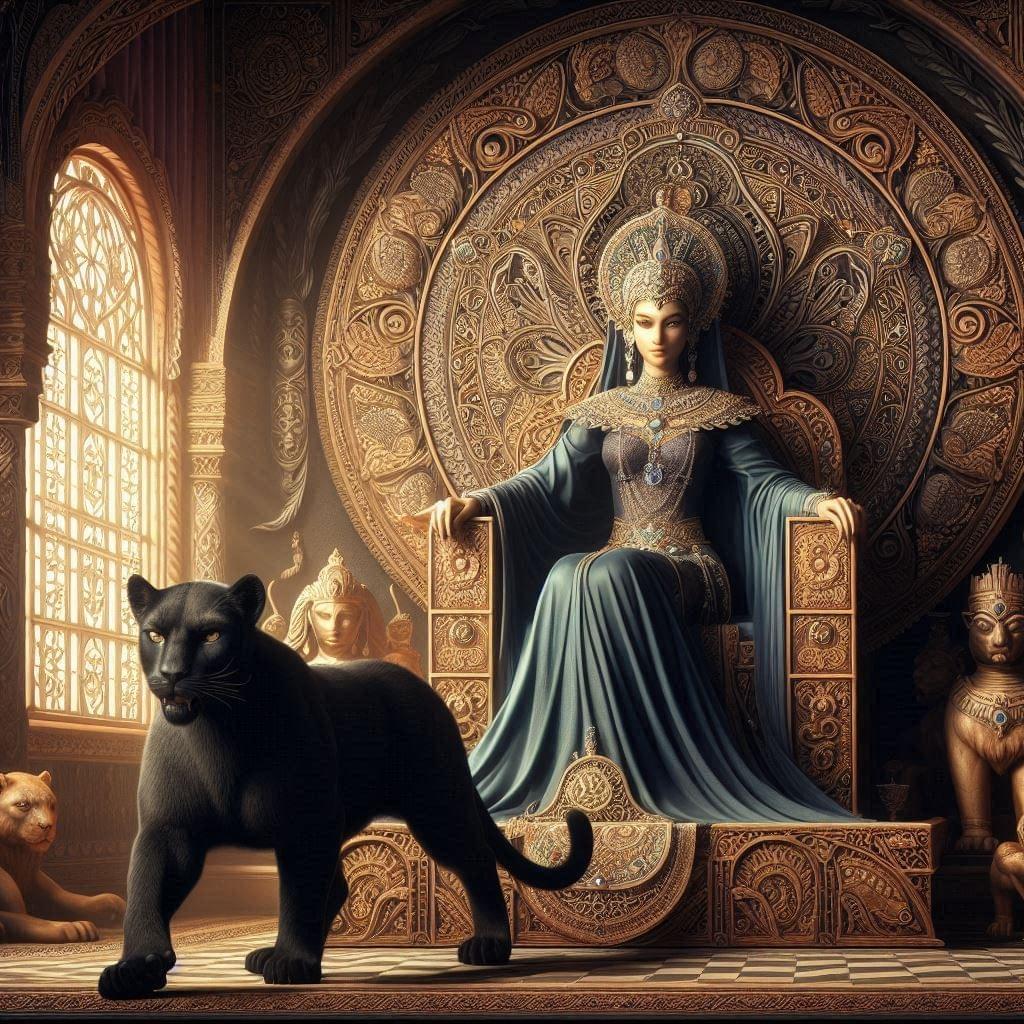
The image of the Great Goddess with a black panther is rich in symbolism, drawing from ancient archetypes, myths, and esoteric traditions. The black panther embodies mystery, power, transformation, and the dark, primal aspects of the Divine Feminine. This imagery often appears in mythological, mystical, and occult traditions, where the panther serves as a symbol of untamed power, night, and the shadow side of creation.
Symbolism of the Great Goddess and the Black Panther (leopard)
The Great Goddess:
- Represents the Divine Feminine in all her forms: nurturing mother, fierce protector, and wise crone.
- Embodies creation, destruction, intuition, and mystery.
- Often associated with lunar cycles, fertility, and the shadow side of life.
The Black Panther:
- Mystery and Darkness: The black panther, with its nocturnal habits and dark coat, symbolizes the mysteries of the night and the hidden realms.
- Power and Courage: It embodies raw, instinctual power, courage, and the ability to face the unknown.
- Transformation and Shadow Work: The black panther, like other shadow animals, represents the journey into the depths of the self to uncover hidden truths and undergo transformation.
- Feminine Energy: The black panther’s grace, strength, and mystery are closely tied to the wild, untamed aspects of the Great Goddess.
Mythological Associations:
- In Greek mythology, the black panther is linked to Dionysus, the god of ecstasy and transformation, whose chariot was sometimes drawn by panthers.
- In esoteric traditions, it is a companion to goddesses like Artemis, Kali, or Hekate, representing independence, primal instincts, and the fierce aspects of femininity.

Thoth-Queen of Wands

Medicine woman

Yin Yang: 0=2
Polarity of the Queen and King of Wands
The Queen of Wands is the female counterpart to the King of Wands. She is the Yin to his Yang, the magnetic to his electric, the lunar to his solar. Where the King embodies the radiant, outgoing force of Fire in its expansive form, the Queen embodies Fire’s receptive, enfolding presence — the vessel of flame, the hearth in which fire takes root.
Together, they form the primal polarity of Sun and Moon, Yang and Yin, electric and magnetic. The King blazes outward, representing solar generative power; the Queen draws inward, representing lunar magnetic sovereignty. Both are necessary, and each defines the other.
As such, the Queen of Wands is more than merely a consort — she is:
Medicine Woman – fiery in her healing and transformative powers.
Earth Mother – rooting Fire in form, giving passion a body and a home.
Magnetic Polarity – attracting, gathering, and holding the current the King projects.
Lunar Sovereign – symbolized by the Moon, her flame reflects and modulates the King’s Sun, bringing balance to the polarity of Fire.
Esoteric Implication
In Hermetic Qabalah, this polarity demonstrates that no force exists in isolation. The Fire of Wands requires both its electric outpouring (King) and its magnetic vessel (Queen). She is the lunar throne of Fire, the Mother of flame, without whom the King’s radiance would burn without form or focus.

In our modern day, she is the Right side of the Brain and He is the Left side. Being the Ultimate Feminine Power, she offers all the Feminine powers, expressed in Myth as Archetypal role models, as well as the power of "Will to Form" and/or Magnetism. Hence, the union of King and Queen produces "electromagnetic "/Light-plasmic children. She is now appearing in the great cycle of Yin vibration, as an expression of Gaia's rebirthing into her Higher Self-Reflection.

Military Industrial Complex.
The She also symbolizes that the days of the Patriarchy/Military Industrial Complex are on the wane. If your core personality is that of the Queen of Wands, life is giving it all to you, good friends, good luck, ideas, and even promotions, so channel this energy into confidence and go after your goals but keep focused on your intentions, for she can become violent and deadly.
[ You have questions? Log onto EliChatGPT , Eli's Thoth Tarot AI, and you'll get quick answers to your tarot and hermetic magick questions.]
When the Queen of Wands card is thrown during a reading, she/he represents:
- Adaptability.
- Persistent energy.
- Calm authority that s/he often uses to add to her/his attractiveness.
- Kind and generous to those who don't oppose her/him.
- Hates opposition.
- Powerfully gracious in love and friendship, all of which is on her/his own terms.
- Such passionate emotion can create a tendency to be sidetracked from goals.
- A deep desire to understand the deeper aspects of self.
- Fiery passion and sharp wit.
- A social dynamo.
- Dangerous.
The negative characteristics of this Queen, as shown by accompanying cards, it implies:
- Vanity and snobbery.
- A tendency to brood, thereby, making wrong decisions that promote acting in great violence.
- Her/his great passion makes her/him easy to deceive, causing a reaction that is both tyrannical and obstinate.
- May be quick to take offense, harboring revenge, often without worthy cause, destructiveness that outweighs joy and love.
Thank you for your interest, comments, and supportive donations. Your self-confident generosity blesses you. May you live long and prosper.
Experience Tarot Readings with a Magus of the Thoth Tarot
Most people think Tarot is about fortune-telling, party tricks, or vague “mystical” predictions you’ve seen in Hollywood films. But the Tarot of Thoth—when read by a trained Magus—is something far more profound.
\
As a Western Hermetic Magus and Master of the Thoth Tarot, I offer one-on-one online readings that go beyond surface-level card meanings. Each session is a direct resonance between myself and the querent—spirit to spirit, mind to mind, body to body.
This is not about guessing your future. It is about awakening clarity, unveiling hidden forces, and aligning you with your own Solar Self. The Thoth Tarot is a Book of Universal Archetypes, encoded with Qabalistic, astrological, and alchemical wisdom. A reading with me brings these forces alive in your life in real time.
How My Readings Differ
Beyond the Mundane: I don’t just “interpret cards.” I read the dynamic flow of your Spirit–Mind–Body alignment through the Tarot’s Qabalistic architecture.
Direct Resonance: My one-on-one sessions are not mechanical. I attune to your presence and read both the seen and unseen currents shaping your life.
Hermetic Depth: As a Magus, I integrate the Tarot with the Tree of Life, planetary forces, and the Divine Archetypes that govern transformation. This opens insights that ordinary readings simply cannot access.
Empowerment, not Dependency: My goal is not to trap you in predictions, but to empower you with vision—so you can consciously co-create your path.
Why Choose a Magus Reading?
Because a true Magus does not read for you—he reads with you. Together, we explore your unique resonance with the living archetypes of the Tarot, peeling away the illusions of false ego and awakening your authentic Self.
✨ Book your private online reading today.
Special sliding-scale pricing is available so no seeker is turned away.
Discover the Tarot not as superstition, but as a sacred key to self-sovereignty, clarity, and transformation.
May you live long and prosper.
3 Western Hermetic Tarot and magick websites helping people become more magic and less tragic since 2010.
Nontraditional Tarot card comparisons blogs, home page, Master Tarot Classes and Tarot Store page.
Traditional Tarot Card comparison blogs and tarot readings store.
Western Hermetic Magick ritual and invocation website and Magick blogs.
